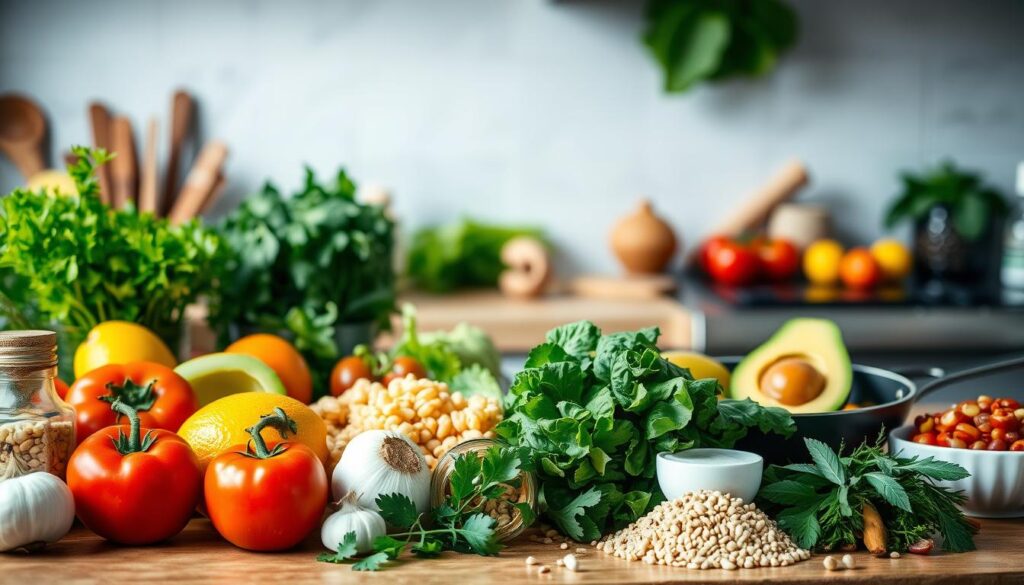Did you know the average American eats about 3,400 mg of sodium every day? This is way over the 2,300 mg limit for a heart-healthy diet1. This shows how important it is to cut down on sodium and saturated fats1.
Good heart health starts with what you eat. The American Heart Association says to keep saturated fat below 6% of your daily calories. This can really lower your heart disease risk1. Knowing and following these dietary tips can change how you eat and keep your heart safe.
Eating heart-healthy isn’t about giving up food. It’s about choosing better options. By picking the right foods and watching what you eat, you can greatly boost your heart health. This can also lower risks from bad eating habits.
Key Takeaways
- The average American consumes excessive sodium daily
- Limiting saturated fat is crucial for heart health
- Strategic dietary choices can protect cardiovascular wellness
- Nutrition plays a critical role in preventing heart disease
- Small changes can lead to significant health improvements
Understanding the Impact of Sodium and Saturated Fats on Heart Health
The food we eat is key to keeping our hearts healthy. Too much sodium and saturated fats can harm our heart health. This can raise the risk of serious health problems.
Knowing how food affects our bodies helps us make better choices. These choices can help protect us from heart disease.
The Sodium-Blood Pressure Connection
Too much sodium can affect blood pressure. Nearly 90% of Americans eat too much sodium, which can lead to health issues2. On average, Americans eat about 4,000 milligrams of sodium each day. This is way above the recommended amount3.
- Recommended daily sodium intake: 2,300 milligrams
- High-risk groups should consume less than 1,500 milligrams
- More than 40% of daily sodium comes from 10 primary food sources2
Saturated Fats and Cholesterol Dynamics
Saturated fats are important for LDL cholesterol levels. Guidelines suggest eating no more than 7% of daily calories from saturated fats4. This helps control cholesterol and lowers heart disease risk.
Comprehensive Heart Disease Risk Assessment
Many things can increase heart disease risk, including what we eat. Eating more polyunsaturated fats can lower heart disease risk4. Making smart food choices can greatly improve heart health.
- Monitor sodium consumption
- Choose heart-healthy fat sources
- Maintain balanced nutritional intake
Common Sources of Hidden Sodium in Your Diet
Many people don’t realize how much sodium is in everyday foods. The average American eats five or more teaspoons of salt each day. This is about 20 times more than our bodies need5. Most of this sodium comes from foods we don’t expect6.
Processed foods are big sources of hidden sodium. Some foods to watch out for include:
- Canned soups with up to 700 mg of sodium per serving6
- Frozen pizzas with 765-957 mg of sodium per slice6
- Deli meats and cold cuts with 497 mg of sodium per serving6
- Bread and bagels with 150-400 mg of sodium7
Restaurant meals also have a lot of sodium. A single submarine sandwich can have 1,127 mg of sodium6. The daily limit for sodium is 2,300 milligrams for people 14 and older7. Diners should be aware that restaurant dishes often exceed this recommendation in just one meal.
To control sodium intake, look for “low sodium” (140 mg or less per serving) or “very low sodium” (35 mg or less per serving) labels7. Reading nutrition labels can help you make better choices and lower your sodium intake.
Identifying and Avoiding High Saturated Fat Foods
It’s important to know where saturated fats come from to keep your heart healthy. Many everyday foods contain these fats, which can harm your heart89.
The Dietary Guidelines for Americans suggest eating less than 10% of your daily calories as saturated fat8. This advice helps lower your risk of heart disease and keeps your cholesterol in check.
Animal-Based Saturated Fat Sources
Animal fats are a big part of saturated fat intake. These include:
- Fatty cuts of beef and pork
- Dark chicken meat with skin
- High-fat dairy products like whole milk, butter, and cheese
- Lard and other animal-based cooking fats
Plant-Based Saturated Fat Sources
Some plant-based foods also have a lot of saturated fats, especially tropical oils:
- Coconut oil
- Palm oil
Processed Food Concerns
Processed foods often have hidden trans fats and saturated fats. The FDA says artificial trans fats are not safe8. Be careful with foods like:
- Baked goods
- Fried foods
- Processed snack items
- Margarine
Pro tip: Always read nutrition labels closely. Even if a product says “zero trans fats,” it might still have up to 0.5 grams per serving10.
Smart Food Swaps for Lower Sodium Intake

Making low-sodium food at home can change how you eat. Using fresh ingredients helps cut down on sodium. It keeps your meals tasty11.
Switching foods can really lower your sodium intake. Here are some good swaps:
- Swap fried tortilla chips for baked corn tortilla chips with lowest sodium available11
- Replace regular potato chips with no-salt pretzels or popped sorghum11
- Choose baked potato chips with reduced sodium instead of traditional versions11
“Eating smart doesn’t mean eating bland – it means eating intentionally”
Dairy alternatives are great for low-sodium options. For example, use fat-free milk and a tablespoon of vegetable oil instead of whole milk11. Soft margarine blended with unsalted cottage cheese can replace cream cheese11.
| High-Sodium Food | Low-Sodium Alternative |
|---|---|
| Fried Chicken Sandwich | Grilled Skinless Chicken Breast |
| Cream-Based Soup | Low-Sodium Vegetable Broth Soup |
| French Fries | Steamed Vegetables |
To cut down on sodium, make smart choices. Choose fresh ingredients and cook meals yourself. Try herbs and spices to add flavor without salt12.
Strategies for Reducing Saturated Fat in Your Diet
To keep your heart healthy, it’s important to control saturated fat intake. The American Heart Association offers advice on how to do this in your meals1314.
When planning meals, focus on lean proteins and healthy fats. These support your heart health. Here are some tips for better dietary choices:
Practical Meal Planning Techniques
- Choose lean proteins like chicken breast, fish, and plant-based options14
- Incorporate cold-water fish rich in omega-3 fatty acids13
- Select low-fat dairy alternatives
- Replace animal proteins with plant-based options when possible13
Understanding Nutrition Labels
Reading nutrition labels is key to managing saturated fat. Look for these important details:
- Check total saturated fat content per serving14
- Aim for less than 6% of total daily calories from saturated fat13
- Look for color-coded labels indicating fat content15
Portion Control Strategies
Controlling portion sizes is crucial for managing saturated fat. A standard serving of meat is about 2-3 ounces, the size of a deck of cards13. Here are some tips:
- Use smaller plates to control serving sizes
- Measure ingredients carefully
- Choose cooking methods like grilling or steaming15
Remember, small changes in your diet can lead to significant improvements in heart health.
Heart-Healthy Cooking Methods and Techniques
Using heart-friendly cooking methods can greatly boost your heart health. Grilling, steaming, and baking are top choices. They cut down on extra fats and keep nutrients in16. These methods also help you eat a balanced diet.
Choosing the right healthy cooking oils is key for heart health. Liquid vegetable oils are better than solid fats. Cooking with little oil helps control calories, with 1 teaspoon having about 40 calories17.
- Baking: A low-fat cooking method that requires no additional oil
- Steaming: Preserves nutrients and eliminates the need for extra fats
- Grilling: Allows fat to drip away from the food
When picking cooking methods, think about these heart-healthy options:
| Cooking Method | Benefits |
|---|---|
| Steaming | Retains maximum nutrients, no added fats |
| Baking | Reduces oil consumption, even cooking |
| Poaching | Minimal fat, gentle cooking technique |
Try herbs, spices, and citrus juices to add flavor without salt or unhealthy fats16. By using these cooking techniques, you can make tasty meals that are good for your heart17.
Incorporating Fresh Fruits and Vegetables for Heart Health
Eating a diet rich in fruits and vegetables is key for heart health. Experts say to eat a variety of colorful foods to get more antioxidants and fiber18. The PURE study found that eating lots of fruits, veggies, and legumes can cut down on death risk by 19%18.
Best Produce Choices for Heart Health
Some fruits and veggies are better than others for your heart. Leafy greens are especially good for lowering heart disease risk19. Here are some top picks for heart health:
- Leafy greens (spinach, kale)
- Berries rich in antioxidants
- Avocados
- Tomatoes
- Citrus fruits
Creative Ways to Add More Produce to Meals
It’s easy to add more fruits and veggies to your meals. The Mediterranean diet suggests eating 2-3 fruits and 4 or more veggies a day20. Here are some easy tips:
- Blend smoothies with mixed fruits and leafy greens
- Add veggies to omelets and scrambled eggs
- Snack on raw veggie sticks with hummus
- Use veggie noodles instead of pasta
- Top salads with fresh fruit slices
Following a plant-based diet can greatly lower heart disease risk. Studies show that eating more plant-based foods can reduce heart disease by 52%18. By choosing the right foods and eating more produce, you can improve your heart health.
Healthy Alternatives to Salt and Saturated Fats

Changing your diet doesn’t mean losing flavor. Herbs and spices are great for adding taste and are good for your heart21. They help you cut down on salt and saturated fats without losing flavor.
Looking for healthy fats to use in cooking is fun. Here are some tasty tips:
- Swap butter with unsweetened applesauce in baked goods21
- Choose olive or canola oils over saturated fats21
- Try fresh herbs like basil, thyme, and rosemary
- Use citrus zests for a burst of flavor
Reducing sodium doesn’t mean your food has to be boring. The 2020-2025 Dietary Guidelines suggest eating less than 2,300 milligrams of sodium a day2. Find salt-free seasoning blends that are full of flavor but still good for your heart.
Omega-3 rich fish like salmon are great alternatives to unhealthy fats21. They’re not just good for you, but they also add amazing flavors to your dishes.
Changing your diet is about making smart, sustainable choices that nourish your body and delight your taste buds.
Understanding Daily Recommended Limits
It can be hard to follow dietary guidelines, but knowing about sodium and saturated fats is key for heart health. The 2020-2025 Dietary Guidelines for Americans offer clear advice on daily nutrition3.
Americans often eat too much sodium. The average intake is about 4,000 milligrams a day, which is almost double the recommended 2,300 milligrams3. Certain populations need to be even more careful, with limits as low as 1,500 milligrams for some3.
It’s also important to watch saturated fats for heart health. Experts say to keep saturated fats under 10% of total daily calories22. For a 2,000-calorie diet, that’s about:
| Nutrient | Daily Recommended Limit |
|---|---|
| Sodium | Less than 2,300 mg |
| Saturated Fat | Less than 10% of total calories |
| Total Fat | Up to 35% of daily calories3 |
People should read nutrition labels, pick heart-healthy foods, and eat a balanced diet to follow these guidelines23. Talking to a healthcare professional can help get advice that fits your health needs.
The DASH Diet: A Heart-Healthy Eating Plan
The DASH eating plan is a detailed way to eat for better blood pressure. It was made by nutrition experts. It’s proven to help keep your heart healthy24. About 47% of adults in the U.S. have blood pressure issues, making this diet very important24.
Key parts of the DASH diet include:
- Fruits and vegetables (4-5 servings daily)
- Whole grains (6-8 servings daily)
- Low-fat dairy products
- Lean proteins
- Limited sodium intake
This diet can lower blood pressure by 5-6 mm Hg for those with high blood pressure24. It’s also linked to a 30% lower risk of heart disease24.
The diet limits sodium to 2,300 milligrams a day. The lower sodium version limits it to 1,500 milligrams25. This helps manage heart health through smart eating.
Following the DASH diet can lower heart disease risk by 25% if you stick to it24. It’s not just for blood pressure. It’s a way to eat better for your heart.
Conclusion: Long-Term Benefits of Reducing Sodium and Saturated Fats
Heart disease prevention starts with changing how we eat. Making small changes in our diet can greatly improve our health over time. Cutting down on sodium and saturated fats is key to keeping our hearts healthy and avoiding heart problems426.
Studies show that making these changes can lead to big health wins. Eating less saturated fat and choosing better fats can lower heart disease risk26. The National Heart, Lung, and Blood Institute says less salt means less heart failure and heart disease4.
Getting advice from doctors is important for a good diet plan. It’s best to make slow, lasting changes for better health. Eating more unsaturated fats, veggies, and watching portion sizes are good steps for heart health4.
Heart health is a journey of making smart choices and taking care of ourselves. Knowing how food affects us and making smart food choices can lower heart disease risk. This improves our life quality a lot.
FAQ
What are the primary health risks associated with high sodium and saturated fat intake?
How much sodium should I consume daily?
What are some unexpected sources of hidden sodium?
How can I reduce saturated fat intake without sacrificing flavor?
What is the DASH diet, and how does it support heart health?
Are all saturated fats equally harmful?
How quickly can dietary changes impact heart health?
What cooking methods support heart health?
Can I still enjoy flavorful meals while reducing sodium and saturated fats?
How do fruits and vegetables contribute to heart health?
Source Links
- The American Heart Association Diet and Lifestyle Recommendations – https://www.heart.org/en/healthy-living/healthy-eating/eat-smart/nutrition-basics/aha-diet-and-lifestyle-recommendations
- Halt the Salt: 5 Ways to Cut Down on Sodium and Improve Your Heart Health – https://www.nhlbi.nih.gov/news/2023/halt-salt-5-ways-cut-down-sodium-and-improve-your-heart-health
- Eating Right for Your Heart – https://www.ucsfhealth.org/education/eating-right-for-your-heart
- Types of Fat – The Nutrition Source – https://nutritionsource.hsph.harvard.edu/what-should-you-eat/fats-and-cholesterol/types-of-fat/
- Guidelines for a Low Sodium Diet – https://www.ucsfhealth.org/education/guidelines-for-a-low-sodium-diet
- 30 Foods High in Sodium and What to Eat Instead – https://www.healthline.com/nutrition/foods-high-in-sodium
- Tame your salt habit – https://www.mayoclinic.org/healthy-lifestyle/nutrition-and-healthy-eating/in-depth/sodium/art-20045479
- Learn the facts about fat – https://www.mayoclinic.org/healthy-lifestyle/nutrition-and-healthy-eating/in-depth/fat/art-20045550
- Good Fats vs. Bad Fats – https://www.healthline.com/health/heart-disease/good-fats-vs-bad-fats
- The Skinny on Fats – https://www.heart.org/en/health-topics/cholesterol/prevention-and-treatment-of-high-cholesterol-hyperlipidemia/the-skinny-on-fats
- Smart Substitutions to Improve Nutrition Without Sacrificing Taste – https://www.heart.org/en/healthy-living/healthy-eating/cooking-skills/cooking/smart-substitutions-to-eat-healthy
- 5 Heart-Healthy Food Swaps – https://www.hopkinsmedicine.org/health/wellness-and-prevention/5-hearthealthy-food-swaps
- 8 steps to a heart-healthy diet – https://www.mayoclinic.org/diseases-conditions/heart-disease/in-depth/heart-healthy-diet/art-20047702
- Saturated Fat – https://www.heart.org/en/healthy-living/healthy-eating/eat-smart/fats/saturated-fats
- How to eat less saturated fat – NHS – https://www.nhs.uk/live-well/eat-well/how-to-eat-a-balanced-diet/eat-less-saturated-fat/
- Heart-Healthy Cooking Tips – https://www.eatright.org/health/health-conditions/cardiovascular-health-heart-disease-hypertension/heart-healthy-cooking-tips
- Heart-Healthy Cooking Tips | Sutter Health – https://www.sutterhealth.org/health/heart-healthy-cooking-tips
- A Heart-Healthy Diet for Cardiovascular Disease Prevention: Where Are We Now? – https://pmc.ncbi.nlm.nih.gov/articles/PMC10128075/
- 17 Incredibly Heart-Healthy Foods – https://www.healthline.com/nutrition/heart-healthy-foods
- Mediterranean diet for heart health – https://www.mayoclinic.org/healthy-lifestyle/nutrition-and-healthy-eating/in-depth/mediterranean-diet/art-20047801
- Simple, heart-smart substitutions: MedlinePlus Medical Encyclopedia – https://medlineplus.gov/ency/patientinstructions/000746.htm
- Cut Down on Saturated Fats – https://health.gov/sites/default/files/2019-10/DGA_Cut-Down-On-Saturated-Fats.pdf
- Fats explained – https://www.bhf.org.uk/informationsupport/support/healthy-living/healthy-eating/fats-explained
- Managing Blood Pressure with a Heart-Healthy Diet – https://www.heart.org/en/health-topics/high-blood-pressure/changes-you-can-make-to-manage-high-blood-pressure/managing-blood-pressure-with-a-heart-healthy-diet
- How to make the DASH diet work for you – https://www.mayoclinic.org/healthy-lifestyle/nutrition-and-healthy-eating/in-depth/dash-diet/art-20048456
- Saturated vs. unsaturated fats: Which is more healthful? – https://www.medicalnewstoday.com/articles/321655




